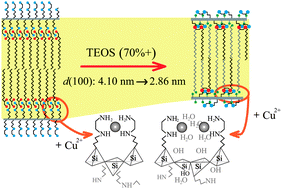Control of spacing between aminoalkyl functions by mesostructural transition in a polysilsesquioxane lamellar assembly†
Abstract
We synthesized lamellar solids by co-condensation of

* Corresponding authors
a
Division of Materials Science and Chemical Engineering, Graduate School of Engineering, Yokohama National University, 79-5 Tokiwadai, Hodogaya-ku, Yokohama, Japan
E-mail:
yos@ynu.ac.jp
b Department of Applied Chemistry, Graduate School of Engineering, Hiroshima University, 1-4-1 Kagamiyama, Higashi-Hiroshima, Japan
We synthesized lamellar solids by co-condensation of

 Please wait while we load your content...
Something went wrong. Try again?
Please wait while we load your content...
Something went wrong. Try again?
H. Yoshitake, H. Nakajima, Y. Oumi and T. Sano, J. Mater. Chem., 2010, 20, 2024 DOI: 10.1039/B920628K
To request permission to reproduce material from this article, please go to the Copyright Clearance Center request page.
If you are an author contributing to an RSC publication, you do not need to request permission provided correct acknowledgement is given.
If you are the author of this article, you do not need to request permission to reproduce figures and diagrams provided correct acknowledgement is given. If you want to reproduce the whole article in a third-party publication (excluding your thesis/dissertation for which permission is not required) please go to the Copyright Clearance Center request page.
Read more about how to correctly acknowledge RSC content.
 Fetching data from CrossRef.
Fetching data from CrossRef.
This may take some time to load.
Loading related content
